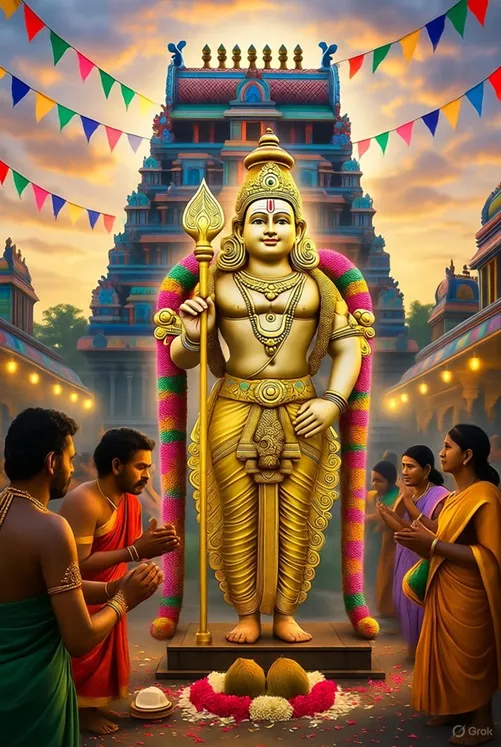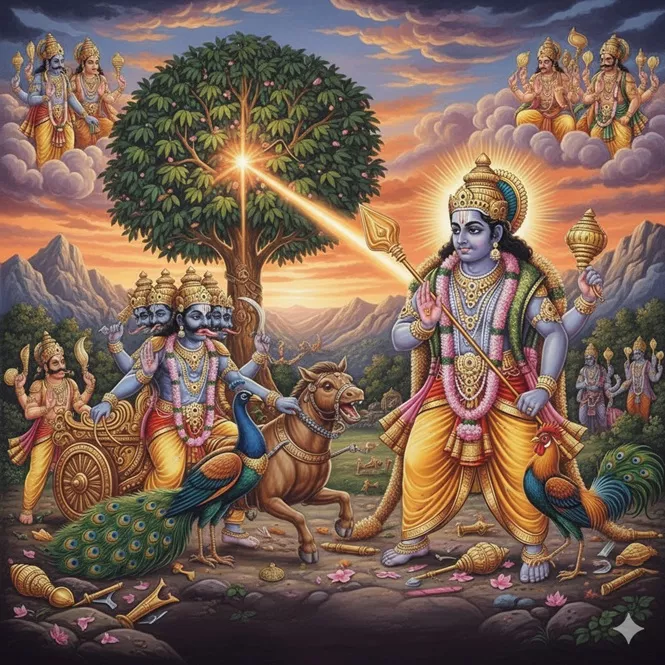- September 24, 2025

The Soorasamharam is an event of profound spiritual significance in Hinduism. It is a vibrant commemoration of Lord Murugan’s heroic triumph over the demon Soorapadman, an act that rescued the celestial beings (Devas). This grand ritual marks the climax of the six-day Kanda Sashti festival. In Tamil Nadu, especially at the Murugan temple in Thiruchendur, this event is celebrated with immense fervor and grandeur.
This article delves into the history, mythology, spiritual importance, rituals, celebrations, and impact of the Soorasamharam. Such spiritual observances are instrumental in nurturing devotion and promoting virtuous conduct in our hearts.
According to the Puranas (ancient scriptures), the demon Soorapadman performed intense penance to Lord Shiva and obtained a powerful boon: he could only be defeated by a being not born from a womb. Arrogant with this invulnerability, he began to relentlessly torment the Devas.
Distressed, the Devas appealed to Lord Shiva. In response, Shiva unleashed six sparks of fire from his third eye. These sparks fell into the Ganges River and eventually transformed into six divine babies. Goddess Parvati then lovingly embraced them, merging them into a single, magnificent form—Lord Murugan (Skanda). Thus, Murugan was born to fulfill the prophecy.
As Murugan grew into a powerful warrior, he first defeated Soorapadman’s brothers, Simhamukhan and Tharakasuran, who were leaders of the demon army sent by Indra (the king of Devas). Finally, the ultimate battle with Soorapadman began. The demon repeatedly changed his form—becoming a mango tree, a mountain, and an elephant—to escape defeat. However, Murugan struck him with his divine weapon, the Vel (spear), splitting him into two halves.
One half transformed into a majestic peacock and the other into a rooster. Lord Murugan, in a display of mercy, accepted them as his mount and his banner, respectively. This act of vanquishing the demon is what is celebrated as Soorasamharam. The Kanda Puranam details this entire epic, and it is also extolled in the devotional hymns of Thiruppugazh by Arunagirinathar.
The Soorasamharam primarily symbolizes the eternal victory of Good over Evil. Soorapadman represents the inner demons of ego, desire, and anger. Murugan’s triumph over him signifies the need to destroy our own negative qualities to achieve spiritual liberation. It is a powerful allegory for the victory of divine wisdom (Gnana) over ignorance.
In Tamil Saivism, Murugan is revered as the Tamil Kadavul (God of the Tamils). This event instills a sense of assurance and faith in devotees. The Sashti tithi (lunar day) is especially auspicious for Murugan, and observing a fast on this day is believed to promote physical and mental well-being. Furthermore, Ayurvedic tradition suggests that fasting during this period helps the body eliminate toxins.

The Kanda Sashti fast spans six days. Devotees typically observe a partial fast, eating only a single meal in the morning and performing puja (worship) in the evening, though some undertake a complete fast. During this period, it is customary to recite devotional hymns like the Kandar Sashti Kavacham and Thiruppugazh.
In the temples, the deities are offered Abhishekam (ritual bathing), intricate Alangaram (decoration), and Deeparadhanai (lighting of lamps). On the day of Soorasamharam, a symbolic effigy of the demon is erected, and a dramatic re-enactment of Murugan destroying him with the Vel takes place, filling the devotees with excitement and devotion.
The fast is typically concluded with the celebration of Thirukkalyanam (divine wedding), where the marriage of Lord Murugan and Goddess Deivanai is enacted. These rituals emphasize family unity and deep devotion.
The Thiruchendur Murugan Temple in Tamil Nadu is the epicenter of the Soorasamharam celebration. Millions of devotees gather here to witness the grand event performed on the seashore. Pujas are conducted from dawn until night. The festival is also celebrated with great fervor at the other five Aarupadai Veedu temples (the six abodes of Murugan) like Palani, Swamimalai, and Thiruparankundram.
Tamil diaspora communities worldwide, such as those who gather at the Batu Caves Temple in Malaysia, also celebrate this festival. The festivities include the distribution of sweets and fruits, as well as participation in bhajans (devotional singing) and folk dances. In the modern era, online pujas allow devotees across the globe to participate in the celebration.
The Soorasamharam has had a profound impact on Tamil culture. It is extensively documented in Tamil literature, especially in the Kanda Puranam. Artists bring the story to life through vibrant paintings and sculptures. Socially, the festival promotes community harmony. Devotees engage in acts of charity, such as offering food to the poor, on this sacred day. The festival also serves as a valuable tool for imparting moral and virtuous teachings to the younger generation.
The Soorasamharam is not just a festival; it is a symbol of our spiritual journey. Through the grace of Lord Murugan, we can conquer our inner evils and attain goodness and enlightenment.
Vetri Vel Muruganukku Arohara!
By celebrating this event, may we find peace and success in our lives.
VetriVel Muruganuku, short, simple and sweet nectar of Kanda Pranam 🙏